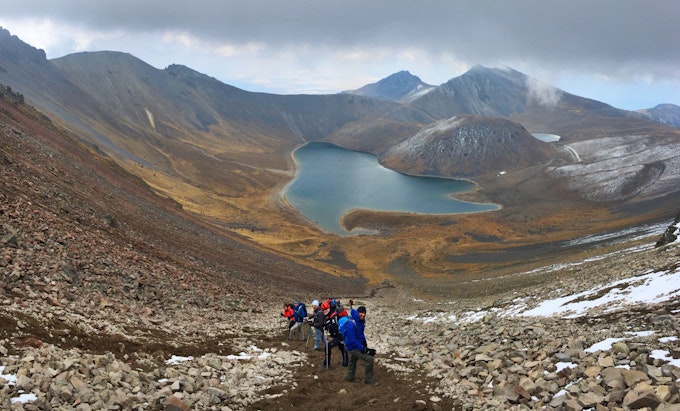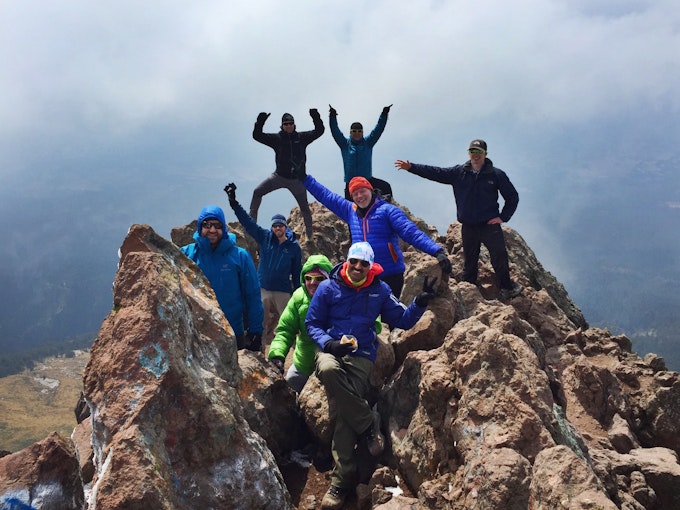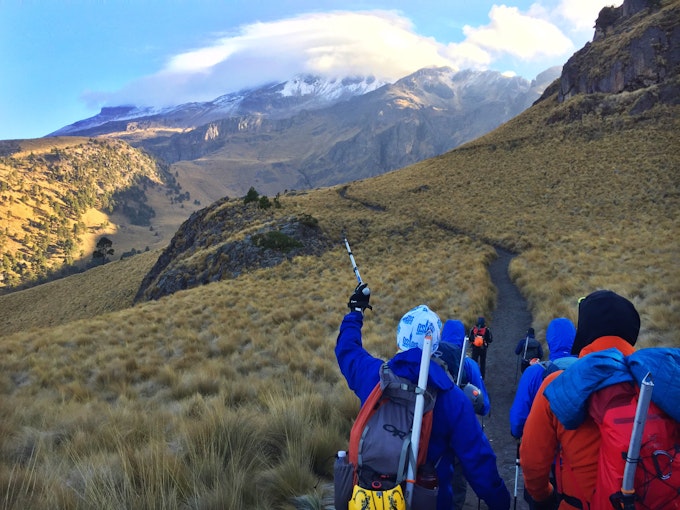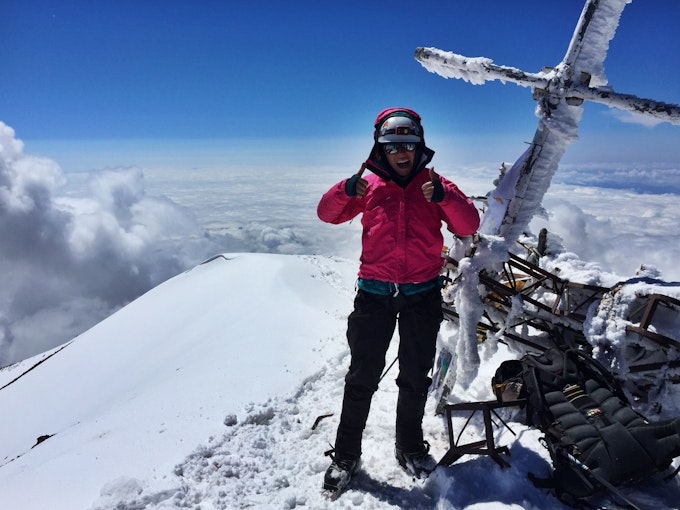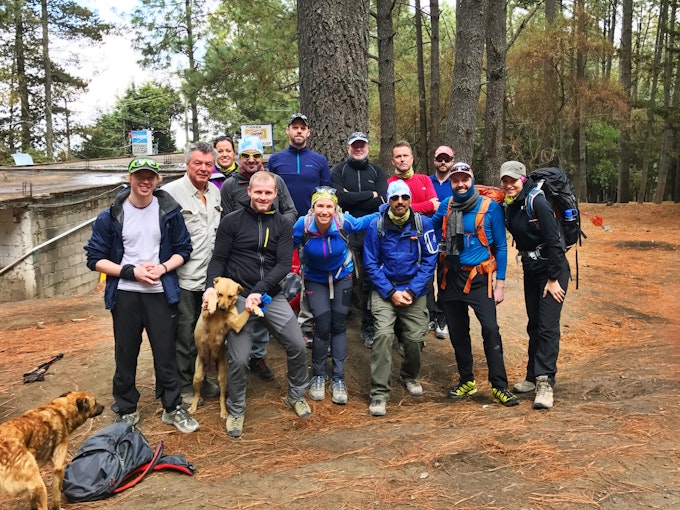Four Volcanoes, Five Days, and Endless Tacos: Climbing Mexico’s Highest Peaks
Turns out mountain climbing and Mexican food couldn't make a more perfect match.

Last week I had the privilege and pleasure of joining a group of mountaineering friends in Mexico on one of the toughest climbing programs I’ve ever participated in. What I expected to be a typical acclimatization-then-climb schedule turned out to be anything but that. Our international team sought to summit a series of 15k, 14k, 17k, and 18k foot volcanoes over the course of a working week. Crazy? Yes. Doable? Surprisingly, yes.
The 13 of us came from every corner of the world: Norway and England, Canada and the United States, even India. We had varying levels of mountaineering experience under our belts, from seasoned Everest-summiters to first-time climbers. But most importantly, we all shared a positive attitude and were bursting at the seams with excitement over this incredible adventure.
Here’s a walk through our high-intensity, high-altitude itinerary of four volcano climbs in five days.
1. Nevado de Toluca (15,354’)
Overview: 6 miles + 1900 feet elevation gain
The Nevado de Toluca National Park is touted as a family-friendly, crowded weekend getaway for local Mexicans – which, by all means, it is. But the imposing summit of Toluca casting down on the sibling lakes of Laguna de la Luna and Laguna de la Sol draws in a different crowd… the type that like to get their hands dirty and fingernails gritty on sharp, steep granite and climb their ways to the top.
We moved fast, spending about an hour on the park’s designated trails before reaching a class 2 or 3 scramble (American grade) that led us up another hour to the summit. Being mid-March, we were just weeks away from Mexico’s wet season and saw the weather changes full force on each of our climbs. Afternoon snowstorms were to be expected.
At the end of our first day, we were all feeling a little more sore than expected, but still stoked for the days to come. We heeded our leader’s warning: It’ll only get tougher.
2. Malinche (14,636’)
Overview: 7 miles + 3700 feet elevation gain
Our climb in La Malinche National Park reminded me of everything I learned about mountaineering on Central Oregon’s volcanoes – including insane amounts of scree.
But far before we hit scree, we enjoyed hiking through a classic Mexican jungle scenery, with thick wooded forests that had tropical canopy tops. We followed a trail for what felt like endless miles until we breached the tree line and set our sights on the summit of Malinche. Everyone appreciated today’s straightforward climb, as there was no guessing which way to go: All slopes point to up.
After everyone celebrated a teammate’s birthday on top with a gigantic Mexican cake and candles (you can’t make this up), we began the long, slow journey down. It was during this relentless descent of our second day that the group began to understand that our weeklong program wasn’t a typical guided itinerary.
My best piece of advice for Malinche hikers: Stick around after your climb to visit the restaurant at base camp / parking lot area, and trust the hostess to tell you what’s good that day.
3. Iztaccihuatl (17,159)
Overview: 6 miles + 4200-5500 feet elevation gain
In the car on the way to the Iztaccihuatl and Popocatepetl National Park, our local guide told me that he was especially excited for today’s climb because he’d never before had clients who had wanted to do it in a single day. This was not a good sign.
Truthfully, the opposing Izta and Popo volcanoes were some of the most breathtaking and scenic mountains I’d ever seen before, but I was having a tough time enjoying their beauty while agonizing over the day’s climb. This route isn’t quite as straightforward as point A to point B. Izta has as many as seven official summits, but our course demanded we ascend and descend three of these, with as much as 300 feet of elevation gain and loss in between. That number may not sound so intimidating at sea level, but after 4 hours and 4k of scree at 17,000 feet – it’s a little more daunting.
Weather again turned on us this day, leaving those who made the summit suffer through a windy whiteout on the way back down. At the end of the day, we did all but crawl back to the car, grateful beyond our years that the following day would be full of rest (and more tacos).
4. Pico de Orizaba (18,491’)
Overview: 4 miles + 5000 feet elevation gain
This is what we all came here for: The chance to stand on top of Mexico’s highest peak, and the 3rd highest peak on the North American continent: Pico de Orizaba. Out tough acclimatization days, and rigorous itinerary, had all been designed so we could reach this one goal.
Today was where most of us finally got within our comfort zone, with crampons strapped to our boots and ice axes leashed to our hands. Since we’d been acclimatized, we slept in the town of Tlachichuca and took off towards the mountain in a 4x4 to start hiking at 5am. Fresh snow caked the ground and warmed us up, and we all shared a spectacular sunrise on the North Face’s infamous Labyrinth, just an hour away from the glacier.
After spending hours with our heads down, focused on the tedious task of navigating across snowy rock fields, the landscape suddenly opened up and we found ourselves at the base of the glacier. Finally, we could see our end goal: the summit of Orizaba. But just as soon as we began celebrating, we were greeted by a harsh warning from a local guide… the top was much farther off than we thought.
And so we began the long, arduous slog up the 45-degree snowfield laden with blue ice and hidden crevasses. A few in our group darted up quickly, without seeming to feel a single effect of the high-altitude atmosphere. Others took their time, carefully following the 2-point rule, anchoring their axe or boot with every step. But eventually each of us made our way up the mountain in splendid time, with the last summiters topping out just 6 hours after we hit the trail. It was a breathtaking, head-splitting moment for many, and an incredible achievement for all.
Orizaba provided all of us with an awesome mountaineering challenge, for both the seasoned and beginner climbers in our group. We got lucky with crystalline snow conditions and a bluebird sky morning. Everyone successfully avoided crevasses, as well as falls or other injuries. It was by all means a perfect day, on the perfect mountain, with the perfect group of people.
At the end of the day, we hiked over a marathon’s worth of miles, climbed over 16,000 vertical feet, and ate no fewer than ten million tacos.
We shouldered our way through uncomfortable cold and slight injury setbacks and we ended nearly every day with a smile and hearty cheers. And most importantly, we did it all without killing each other.
If it’s possible to do something, it’s possible to do it bigger and better – which is just what we’re planning for next year! Here we come, Ecuador 2018!
We want to acknowledge and thank the past, present, and future generations of all Native Nations and Indigenous Peoples whose ancestral lands we travel, explore, and play on. Always practice Leave No Trace ethics on your adventures and follow local regulations. Please explore responsibly!
Do you love the outdoors?
Yep, us too. That's why we send you the best local adventures, stories, and expert advice, right to your inbox.


